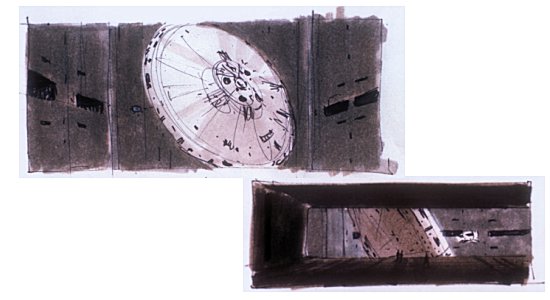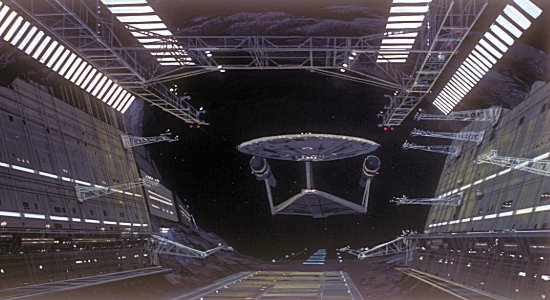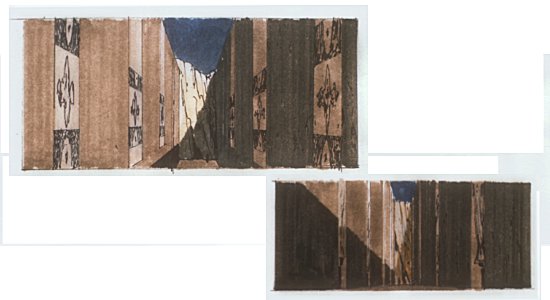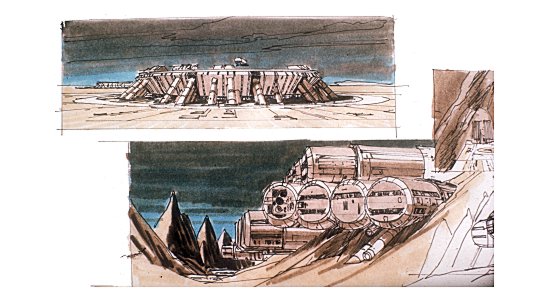I recently purchased the very huge, very cool, and very expensive book "The Art of Ralph McQuarrie", six pages of which are dedicated to McQuarrie's conceptual art for what is listed in the book as "Unfilmed Star Trek Feature, late 1970s", better know to Trek historians as Philip Kaufman's aborted film "Star Trek: Planet of the Titans".
The best thing is seeing large reproductions of several of McQuarrie's concept paintings that most of us have seen before, and conceptual sketches, most of which I'd seen elsewhere. But what made this extra interesting was Ralph's notes on the images. Since much of what's known about this project is rumor and assumption, I thought I'd dig up some of the images in the book and note what McQuarrie says about them, and what hints that provides about what was and wasn't planned for the film.
NOTE that the images here are ones I've seen all over the net and had on my hard drive. I didn't dare try to put this big ol book into a scanner!
As to the Enterprise, some of the sketches in the book show close-ups of the nacelle fronts, which are shown to have domed ends, but these are recessed into the front of the nacelle cylinders: a detail not apparent on the photos I've seen of the study models.
The best thing is seeing large reproductions of several of McQuarrie's concept paintings that most of us have seen before, and conceptual sketches, most of which I'd seen elsewhere. But what made this extra interesting was Ralph's notes on the images. Since much of what's known about this project is rumor and assumption, I thought I'd dig up some of the images in the book and note what McQuarrie says about them, and what hints that provides about what was and wasn't planned for the film.
NOTE that the images here are ones I've seen all over the net and had on my hard drive. I didn't dare try to put this big ol book into a scanner!
The caption above seems to confirm that the design of the ship was that of Ken Adam, not McQuarrie's per se, despite what some people want to see as a Star Destroyer influence. This explanation fits with the Adam sketches of the ship seen in The Art of Star Trek.Above: Ralph's rendering of designer Ken Adam's concept for the Enterprise.
Ok, the nonsense about dense material negating gravity aside, the many sketches of the detached saucer, in the "shroud", shown landed, and the various landing pads on what appears to be Earth and Vulcan all appear to indicate that the artists at least were toying with the idea of a ship that routinely separates, leaving the warp drive in orbit while the saucer lands on planets.
(in the book, text below the upper image reads "crew uses tiny pod to cross to opening in shaft)
McQuarrie:
I had devised a concept for the end of the film... Some alien form has designed a way to use the power of a black hole's gravity to form a spherical shroud around the black hole. If you have a dense enough material, gravity cannot penetrate it. There are two openings in the shroud that they would use to pull ships in. The saucer of the Enterprise (which was detachable) ends up in the shroud. They meet the aliens and had a dramatic finale. These two images are of the Enterprise saucer in the shroud.
Detached Enterprise saucer concept sketch.
The disc of the enterprise <sic> would separate from the rest of the ship to land on the surface of planets.
Landing platform concept sketch.
...concept sketches of the detached Enterprise dish on the surface of a planet.
It appears the artists were blue-skying ideas while the scripts were being developed, suggesting many ideas that probably never made it into the actual screenplays.Asteroid Docking Bay production painting.
There was no script, we were just winging it, coming up with all kinds of ideas. I was able to introduce my inhabited asteroid concept, which again went unused when the the plans for a feature film were dropped for a few years.
Asteroid Docking Bay Interior production painting and thumbnail sketches.
As to the Enterprise, some of the sketches in the book show close-ups of the nacelle fronts, which are shown to have domed ends, but these are recessed into the front of the nacelle cylinders: a detail not apparent on the photos I've seen of the study models.
Last edited:






